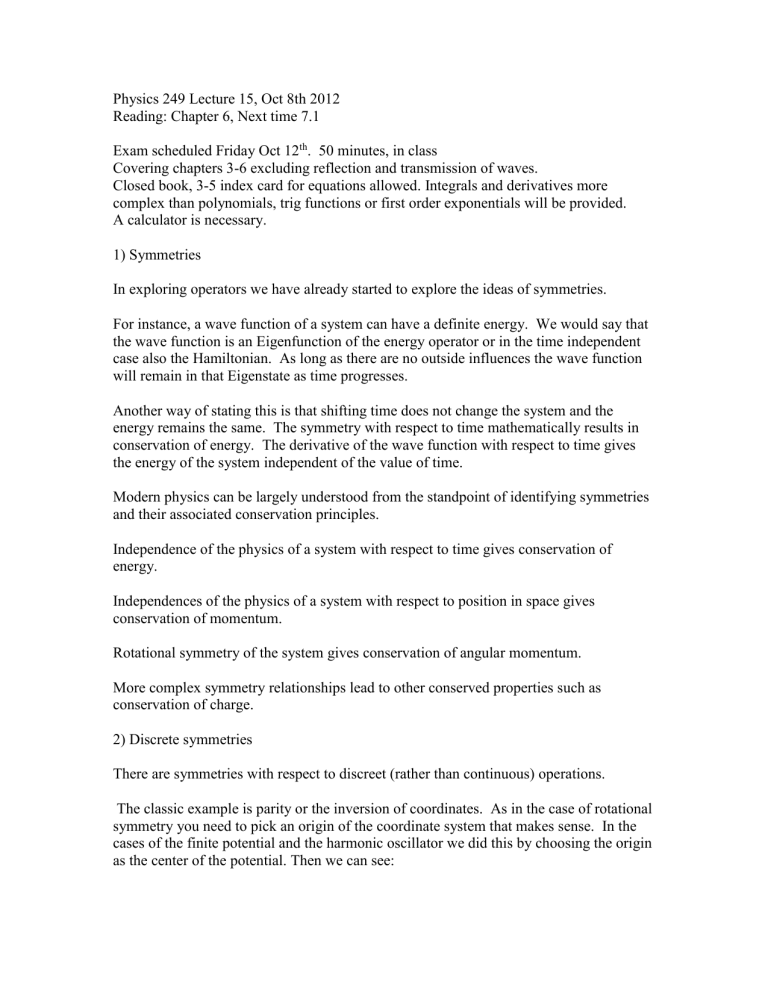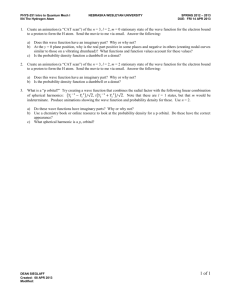Lecture_15

Physics 249 Lecture 15, Oct 8th 2012
Reading: Chapter 6, Next time 7.1
Exam scheduled Friday Oct 12 th
. 50 minutes, in class
Covering chapters 3-6 excluding reflection and transmission of waves.
Closed book, 3-5 index card for equations allowed. Integrals and derivatives more complex than polynomials, trig functions or first order exponentials will be provided.
A calculator is necessary.
1) Symmetries
In exploring operators we have already started to explore the ideas of symmetries.
For instance, a wave function of a system can have a definite energy. We would say that the wave function is an Eigenfunction of the energy operator or in the time independent case also the Hamiltonian. As long as there are no outside influences the wave function will remain in that Eigenstate as time progresses.
Another way of stating this is that shifting time does not change the system and the energy remains the same. The symmetry with respect to time mathematically results in conservation of energy. The derivative of the wave function with respect to time gives the energy of the system independent of the value of time.
Modern physics can be largely understood from the standpoint of identifying symmetries and their associated conservation principles.
Independence of the physics of a system with respect to time gives conservation of energy.
Independences of the physics of a system with respect to position in space gives conservation of momentum.
Rotational symmetry of the system gives conservation of angular momentum.
More complex symmetry relationships lead to other conserved properties such as conservation of charge.
2) Discrete symmetries
There are symmetries with respect to discreet (rather than continuous) operations.
The classic example is parity or the inversion of coordinates. As in the case of rotational symmetry you need to pick an origin of the coordinate system that makes sense. In the cases of the finite potential and the harmonic oscillator we did this by choosing the origin as the center of the potential. Then we can see:
a) There is a symmetry in the potential are x=0, V(x) = V(-x). b) Since the Schrodinger equation, which describes the physics of the system, only involves x in the potential that symmetry is true of the whole Schrodinger equation and thus the physics of the system. c) Observable properties of the system such as the probability density as a function of space are parity symmetric. 𝜓 ∗ (𝑥)𝜓(𝑥)𝑑𝑥 = 𝜓 ∗ (−𝑥)𝜓(−𝑥)𝑑𝑥 d) Examining other properties we find that they are also parity symmetric.
𝐻𝜓(𝑥) = 𝐸𝜓(𝑥) ⇒ 𝐻𝜓(−𝑥) = 𝐸𝜓(−𝑥) e) Now consider a parity operator
𝑃𝜓(𝑥) = 𝜓(−𝑥) and
𝐻𝜓(−𝑥) = 𝐸𝜓(−𝑥) ⇒ 𝐻𝑃𝜓(𝑥) = 𝐸𝑃𝜓(𝑥)
For this to be true P does cannot change the functional dependence of the wave function on x requiring that the P operation returns a constant.
𝑃𝜓(𝑥) = 𝑝𝜓(𝑥)
To understand what values the constant p can have consider:
𝑃𝑃𝜓(𝑥) = 𝑝𝑃𝜓(𝑥) = 𝑝 2 𝜓(𝑥) = 𝜓(𝑥)
Therefore p=+-1
For the two potentials we considered this is precisely what we observed. Changing x to – x either left the wave function unchanged p=1, the symmetric parity even case, or inverted the wave function p=-1, the anti symmetric parity odd case.
The interesting physics is that there is an operator P and the wave functions are
Eigenstates of the operator with eigenvalues +-1. In terms of conservation principles there is some discrete value for parity, which is conserved.
3) Transitions
Physically you would expect that there must be some overlap in space between two wave functions if you want to induce a transition between them. Mathematically this is can be states as.
∞
∫ 𝜓 ∗ 𝑛
−∞
(𝑥, 𝑡)𝑥𝜓 𝑚
(𝑥, 𝑡)𝑑𝑥 ≠ 0
In the case of the harmonic oscillator it this integral is only nonzero when 𝑛 = 𝑚 ± 1
That means that all transitions have energy ℏ𝜔 . This finally demonstrates a statement we made previously that the frequency of the light emitted or absorbed has to match the
(classical) frequency of oscillation of the molecules in a blackbody.
Consider parity. Evidently you can have transitions that change the parity. To understand conservation of parity you must consider the whole system including the photon, which has its own parity. The difference in parity is introduced or carried away by the photon in absorption of emission respectively.
4) Reflection and transmission of waves.
The reflection and transmission of particle waves can be understood using the
Schrodinger equation.
Consider a step potential and a particle wave going in the positive direction with energy greater than the potential.
V(x)=0
V(x)=V
0 x<0 x>0
Though you are considering a wave moving with time the potential is static and the time independent Schrodinger equation is appropriate. ℏ 2
𝐸𝜓(𝑥) = −
2𝑚
𝜕 2 𝜓(𝑥)
+ V(x)𝜓(𝑥)
𝜕𝑥 2 x<0
𝜕 2 𝜓(𝑥) 𝑘
1
𝜕𝑥 2
=
= −𝑘
√2𝑚𝐸 ℏ
2
1 𝜓(𝑥) x>0
𝜕 2 𝜓(𝑥) 𝑘
2
𝜕𝑥 2
=
= −𝑘 2
2 𝜓(𝑥)
√2𝑚(𝐸 − 𝑉
0
) ℏ and general solutions 𝜓
1
(𝑥) = 𝐴𝑒 𝜓
2
(𝑥) = 𝐶𝑒 𝑖𝑘
1 𝑥 𝑖𝑘
2 𝑥
+ 𝐵𝑒 −𝑖𝑘
1 𝑥
+ 𝐷𝑒 −𝑖𝑘
2 𝑥
Recognizing these as right and left going wave D=0 since there is no initial wave coming from the right.
Solving the problem is simply a matter of equating the wave function and first derivative of the wave function at the potential boundary.
More interesting is comparing the probability for a wave to exist as a right moving, transmitted wave, or left moving, reflected, wave after encountering the barrier relative to the original right going wave.
𝑅 = 𝑅𝑒 (
|𝐵| 2
|𝐴| 2
) = ( 𝑘
1 𝑘
1
𝑇 = 𝑅𝑒 ( 𝑘
2 𝑘
1
|𝐶| 2
|𝐴| 2
) =
− 𝑘
2
+ 𝑘
2
)
2
(𝑘
4𝑘
1 𝑘
2
1
+ 𝑘
2
) 2
These should be understood within the context of the probabilistic interpretation of the wave function. At a given energy percentages R and T of the particles will be reflected or transmitted.
Note that these reflection and transmission probabilities are energy dependent. When considering a wave packet the wave packet will be distorted by the potential barrier.







